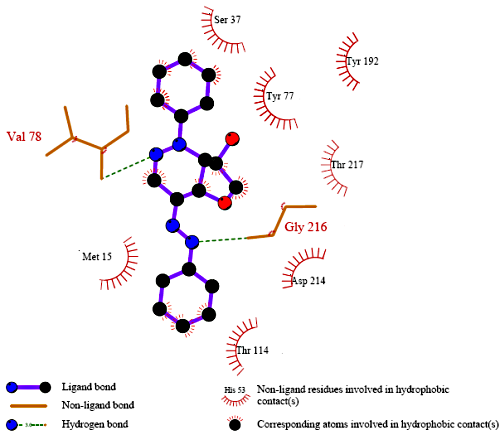
Aspartic protease inhibitory and nematocidal activity of phenyl-4-(2-phenylhydrazono)hexahydrofuro[3,2-c]pyridazin-7-ol (Percival dianhydroosazone)
Abstract
We synthesized Phenyl-4-(2-phenylhydrazono) hexahydrofuro[3,2-c]pyridazin-7-ol (compound 3). The structure compound 3 was elucidated with IR, 1H NMR, 13C NMR and EIMS spectra. Compound 3 showed potent inhibitory activity against aspartic proteases, human cathepsin D and Plasmodium falciparum plasmepsin-II with IC50 = 20 μM. Enzyme-inhibitor complexes were predicted to stabilize by electrostatic and hydrophobic interactions between the side chains of amino acid residues at the active center and compound 3. Moreover, compound 3 displayed good nematocidal activity against all developmental stages of C. elegans.
Full Text:
PDFReferences
- K. Ersmark, B. Samuelsson, A. Hallberg, Plasmepsins as potential targets for new antimalarial therapy. Med. Res. Rev., 2006, 26, 626-666.
- E. De Clercq, Strategies in the design of antiviral drugs. Nat. Rev. Drug Disc., 2002, 1, 13-25. (b) S. K. Saxena1, S. Saxena, R. Saxena, M. L. A. Swamy, A. Gupta, , M. P.N. Nair, Emerging trends, challenges and prospects in antiviral therapeutics and drug development for infectious diseases. Electr. J. Biol., 2010, 6, 26-31.
- A. Jedinak, T. Maliar, Inhibitors of proteases as anticancer drugs. Neoplasma, 2005, 52, 185-192.
- M. K. Azim, Z. H. Zaidi, Molecular modeling of human procathepsin E: analysis of salt-bridge interactions between propeptide and enzyme segment. Biochem. Biophys. Res. Commun., 1999, 264, 825-832.
- J. D. Cooper, C. Russell, H. M. Mitchison, Progress towards understanding disease mechanisms in small vertebrate models of neuronal ceroid lipofuscinosis. Biochim. Biophys. Acta, 2006, 1762, 873-889.
- M. J. Humphreys, R. P. Moon, A. Klinder, S. D. Fowler, K. Rupp, D. Bur, R. G. Ridley, C. Berry, The aspartic proteinase from the rodent parasite Plasmodium berghei as a potential model for plasmepsins from the human malaria parasite, Plasmodium falciparum. FEBS Lett., 1999, 463, 43–48.
- K. Ersmark, M. Nervall, E. Hamelink, L. K. Janka, J. C. Clemente, B. M. Dunn, M. J. Blackman, B. Samuelsson, J. Aqvist, A. Hallberg, Synthesis of malarial plasmepsin inhibitors and prediction of binding modes by molecular dynamics simulations. J. Med. Chem., 2005, 48, 6090-6106.
- F. Hof, A. Schutz, C. Fah, S. Mayer, D. Bur, J. Liu, D. E. Goldberg, F. Diederich, Starving the malaria parasite: inhibitors active against the aspartic proteases plasmepsins I, II, IV. Angew. Chem., 2006, 45, 2138-2141.
- S. Bjelic, M. Nervall, H. Gutierrez-de-Teran, K. Ersmark, A. Hallberg, J. Aqvist, Potent, low-molecular-weight non-peptide inhibitors of malarial aspartyl protease plasmepsin II. J. Med. Chem., 1999, 42, 1428–1440. (b) D. Gupta, R.S. Yedidi, S, Varghese, L, C. Kovari, P. M. Woster, Mechanism-based inhibitors of the aspartyl protease Plasmepsin II as potential antimalarial agents. J. Med. Chem., 2010, 53, 4234–4247.
- W. Ahmed, M. Rani, I. A. Khan, A. Iqbal, K. M. Khan, M. A. Haleem, M. K. Azim, Characterisation of hydrazides and hydrazine derivatives as novel aspartic protease inhibitors. J. Enz. Inhib. Med. Chem., 2010, 25, 673-678.
- M. Rarey, B. Kramer, T. Lengauer, G. Klebe, A fast FlexXible docking method using an incremental construction algorithm. J. Mol. Biol., 1996, 261, 470-489.
- (a) E. S. H. El Ashry, Y. El Kilany and N. M. Nahas, Heterocycles from Carbohydrate Precursors: Topics in Heterocyclic Chemistry; ed. by E. S. H. El Ashry; Springer: 2007, 7, pp. 1-30. (b) Z. H. Abdellfattah, E. S. H. El Ashry, J. Banoub, Synthesis and structural characterization of 1-(D-glycosyloxy)phthalazines. Carbohydr. Res., 2003, 338, 2291-2299.
- (a) M. L. Wolfrom, M. Konigsberg, S. Soltzberg, Estimation of O-Acetyl and N-Acetyl and the Structure of Osazone Acetates. J. Amer. Chem. Soc., 1936, 58 490-491. (b) H. El Khadem, M. M. A. Abdel Rahman, The configuration and formation of Percival dianhydroosazone. J. Org. Chem., 1966, 31, 1178–1180.
- (a) E. G. V. Percival, Studies on osazones: d- and l- dianhydrohexosazone. J. Chem. Soc., 1938, 1384-1386. (b) K. Bougrin, A. Loupy, M. Soufiaoui, Microwave-assisted solvent free heterocyclic synthesis. J. Photochem. Photobiol. C: Photochem. Rev., 2005, 6, 139-167.
- A. M. Silva, A. Y. Lee, S. V. Gulnik, P. Maier, J. Collins, T.N. Bhat, P. J. Collins, J. W. Erickson, Structure and inhibition of plasmepsin II, A hemoglobin-degrading enzyme from Plasmodium falciparum. Proc. Natl. Acad. Sci. USA., 1996, 93, 10034-10039.
- K. G. Simpkin, G. C. Coles, The use of Caenorhabditis elegans for anthelmintic screening. J. Chem. Tech. Biotechnol., 1981, 31, 66–69. (b) L. M. Katiki, L. F. Ferreira, A. M. Zajac, C. Masler, Caenorhabditis elegans as a model to screen plant extracts and compounds as natural anthelmintics for veterinary use. Vet. Parasitol. 2011, 15, 264-268.
- S. H. Jang, Y. Park, S. C. Park, P. I. Kim, D. G. Lee, K. S. Hahm, Antinematodal activity and the mechanism of the antimicrobial peptide, HP (2-20), against Caenorhabditis elegans. Biotech. Lett., 2004, 26, 287-291. (b) M. K. Azim, M. Sajid, Evaluation of nematocidal activity in natural honey. Pak. J. Bot., 2009, 41, 3261-3264.
- K. Bougrin, A. Loupy, M. Soufiaoui, Microwave-assisted solvent free heterocyclic synthesis. J. Photochem. Photobiol. C: Photochem. Rev., 2005, 6, 139-167.
- A. C. Wallace, R. A. Laskowski, J. M. Thornton, LIGPLOT: a program to generate schematic diagrams of protein–ligand interactions. Prot. Eng. 1995, 8, 127–134.
- H. J. Bohm, The development of a simple empirical scoring function to estimate the binding constant for a protein-ligand complex of known three-dimensional structure. J. Comput. Aided Mol. Des., 1994, 8, 243-256.
- T. Stiernagle, Maintenance of C. elegans, The C. elegans Research Community; ed. by Worm Book; Worm Book, 2006, doi/10.1895/worm book.1.101.1.
- A. M. Ibrahim, Anthelmintic activity of some Sudanese medicinal plants. Phytotherap. Res., 1992, 6, 155–157.
DOI: http://dx.doi.org/10.13171/mjc.3.2.2014.22.04.23
Refbacks
- There are currently no refbacks.
Copyright (c) 2015 Mediterranean Journal of Chemistry
